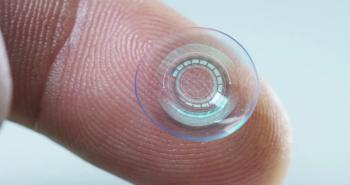
5 things you need to know: Urine in pools causes red eyes
The Centers for Disease Control and Prevention (CDC) recently told Women’s Health magazine that the reason some swimmers get red eyes after a dip in the pool isn’t the chlorine-it’s the urine in the water.
Urine causes red eyes after swimming in a pool
Atlanta-The Centers for Disease Control and Prevention (CDC)
Michael J. Beach, PhD, associate director of the CDC’s
“This report will make you think before ever getting in a public pool,” says Chief Optometric Editor Ernie Bowling, OD, FAAO. “Remember even though you’re there for fun, you are potentially sharing body fluids with the entire populace. I recommend no one ever open their eyes underwater, and recommend swimming goggles. And of course remove contact lenses before swimming.”
Heading to the pool? Take a shower and a bathroom break first. Don’t ever pee in the water (and, no-we know what you’re thinking-you’re not safe to do it in a lake or ocean either). The CDC also recommends that people refrain from swimming if they’re sick or have any open wounds.
Bionic Lens to offer better than 20/20 vision
Surrey, British Columbia-A new intraocular lens will offer better than 20/20 vision with an eight-minute procedure similar to cataract surgery. Might this be a better choice than glasses or contact lenses?
British Columbia optometrist Garth Webb, who invented the
According to Ocumetrics, the lens is made of inert biocompatible polymetric materials that do not cause adverse biophysical changes within the eye.
The custom-made lens is folded in a saline-filled syringe would be placed in the eye, where it would unravel itself within 10 seconds. The lens replaces the natural lens and would be an option for someone who depends on corrective lenses and is over the age of 25.
"I'm certainly intrigued by the whole concept, but have to remain skeptically optimistic," says Optometry Times Editorial Advisory Board member Joe Shovlin, OD, FAAO, DPNAP. "Apparently, it's an intraocular lens that somehow 'auto regulates' within the eye. Not really sure what the mechanism might be-whether it's a fluid dynamic or transfer principle, I can't be certain without evaluating the patents.
"Regardless, the promotional appears to be somewhat disingenuous. For example, 'You'll never get cataracts ever.' Well, that's accurate because you had your lens removed for the procedure," says Dr. Shovlin.
Pending clinical trials, Dr. Webb says the Bionic Lens could be
Glaucoma market to grow to $3 billion by 2023
London-The glaucoma treatment market is expected to grow across from $2.4 billion in 2013 to $3 billion by 2023,
The growth-which is projected for the seven major markets: U.S., France, Germany, Italy, Spain, UK, and Japan-was described as moderate, with a compound annual growth rate (CAGR) of 2.4 percent.
According to the report, the growth will be driven by first-in-class drugs-such as Rhopressa/Roclatan (Aerie), Vesneo (latanoprostene bunod, Bausch + Lomb), and trabodenoson (Inotek)-and the introduction of additional fixed-dose combination (FDC) products, such as Tapcom/Taptiqom (tafluprost/timolol maleate, Santen) and Simbrinza (brinzolamide/brimonidine tartrate ophthalmic suspension, Alcon).
“The six products anticipated to enter the seven major markets during the forecast period will collectively generate sales of $672 million by 2023, constituting a 22.2 percent share of the global market,” says Catherine Daly, PhD, senior analyst with GlobalData. “Aerie’s Roclatan is forecast to achieve the highest sales among these drugs, and is expected to generate approximately $262 million in 2023. Significant uptake of Roclatan in the U.S., due to the drug’s enviable position of becoming the first prostaglandin, analog-containing FDC product available in this large arena, will be the main overall market driver.”
The GlobalData report also states that the U.S. will consolidate its position as the dominant country for glaucoma treatment within the major markets. U.S. sales are expected to increase from $1.7 billion in 2013 to $2.2 billion by 2023 at a CAGR of 2.5 percent, with its overall market share rising slightly from 70.7 percent to 71.6 percent over the same period.
“This increase is mainly attributed to the expected introduction of several new products between 2013 and 2023, and the overall increase in glaucoma prevalence that is mostly due to an aging society in the U.S.,” says Dr. Daly. “However, Allergan will lose patent protection for its FDC drug Combigan in 2022, allowing generic brimonidine + timolol FDC products to enter the arena. This will negatively impact the U.S. market value and slow the overall growth rate in the last two years of the forecast period.”
Conventional as good as femtosecond laser-assisted cataract surgery
San Diego-Patients who undergo conventional cataract surgery do no show a significant difference in refractive outcomes or best-corrected visual acuity (BCVA) than those treated with femtosecond laser-assisted surgery, according to a recent study presented at the American Society of Cataract and Refractive Surgery 2015 Symposium.
Related:
Kendall Donaldson, MD, from the Bascom Palmer Eye Institute, and her team retrospectively analyzed 621 eyes in 509 patients whose cataracts were treated with either conventional or femtosecond laser-assisted surgery at Bascom Palmer. The femtosecond laser-assisted surgery patients were treated using either Abbott’s Catalys system or Alcon’s LenSx system.
The study found that the rates of refractive error were not statistically different for the three groups-conventional, Catalys, and LenSx. Fewer patients treated with conventional cataract surgery attained vision of at least 20/20 (62 percent vs. 100 percent of laser surgery patients) or at least 20/40 (80 percent vs. 98 percent of laser surgery patients), but the difference in BCVA was not significantly different.
Related:
The researchers also analyzed 74 eyes in 42 patients who received toric intraocular lenses for astigmatism. While laser surgery performed better than conventional surgery, the difference was not significant.
Dr. Donaldson concluded that it is still not clear whether femtosecond laser-assisted cataract surgery is better than conventional methods.
New GA law allows OD/OMD corporate partnerships
Atlanta-Georgia Governor Nathan Deal recently signed
The Georgia Optometric Association (GOA) began working on HB 316 (Reeves, Meadows) beginning around November 2014 after receiving multiple questions from members about why optometrists and ophthalmologists could not jointly own a practice, says Hannah Leach, GOA communications and advocacy coordinator.
Related:
“The law creates an additional and simpler mechanism for optometrists and ophthalmologists to work together by allowing them to enter into a corporate partnership with one another,” Leach says. “Optometry and ophthalmology are the only medical exemptions to Georgia's current law that prohibits different professions from jointly owning a practice.”
The law goes into effect July 1.
Newsletter
Want more insights like this? Subscribe to Optometry Times and get clinical pearls and practice tips delivered straight to your inbox.















































